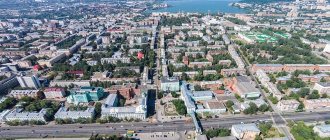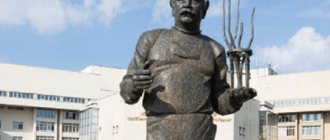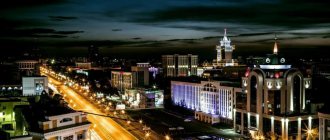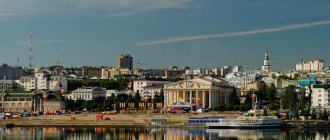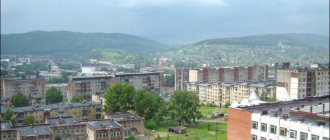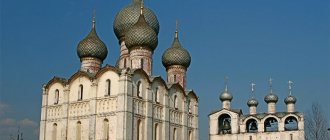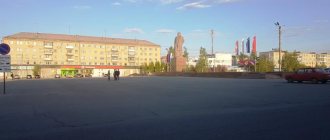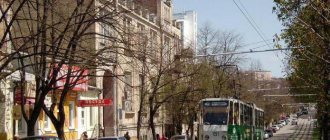How many people live in the city of Izhevsk, what is the population as of January 1, 2022, what number of people live officially, is it increasing or decreasing in municipal areas, growing or vice versa, decreasing, decreasing and where?
Statistics have always interested people and no matter what it concerns, and we are interested in it for a variety of reasons, out of curiosity and for other, very different reasons, we want to know about something, for example, about a given topic, which we will deal with below.
Izhevsk is the pride of Russian industry
The capital of the Republic of Udmurtia received the status of an urban settlement only after the October Revolution, in 1918. However, during these decades a huge leap forward was made both in terms of industrial and cultural development. The assignment of the status of a city of labor glory was a natural result of all the processes that took place here throughout the twentieth century.
The population of the city of Izhevsk is famous for its traditions in various fields of culture, science, education and, of course, for its production successes, talent, hard work and creative approach to any business. The capital of Udmurtia is a multinational city. At the same time, he is an example for all other cities and regions of our country of how Russians and Udmurts, Mordovians and Tatars, Ukrainians and Jews can get along well and cooperate fruitfully.
Izhevsk
Video: Izhevsk
Basic moments
Izhevsk from a bird's eye view
Izhevsk stands between the Kama and Vyatka, on the Izh River, which divides it into two parts. The city is located 1200 km from Moscow and lives according to Samara time. The day comes here an hour earlier than in the capital of Russia. Streets and houses were built on a hilly plain, and the features of the relief were reflected in the old names of Izhevsk districts and streets - Gorka, Malinovaya Gora, Nagorny and Zareka. The highest place of the Udmurt capital is in the Eastern village (208 m), and the southern part of the urban area lies in the lowlands.
The historical center of Izhevsk was formed around former state-owned factories. You can come here by different types of public transport, but the most convenient way to do this is by tram number 11. The main architectural monuments and museums of the city are associated with the production of small arms. This is a monument to Izhevsk gunsmiths, a museum of the history of OJSC Izhmash, as well as a museum and exhibition complex of small arms, which bears the name of Mikhail Timofeevich Kalashnikov.
Monument to Izhevsk gunsmiths
Monument to Peoples' Friendship
The city has many beautiful temples, unusual monuments, interesting museums and pleasant green areas for walking. Tourists who come here try to take away weapons-themed souvenirs as a souvenir of their stay in Izhevsk. Patterned woolen socks and mittens, dolls in national Udmurt costumes and paintings by local artists are also popular among travelers.
Lenin Street in Izhevsk
Tower of the Main Building of Izhevsk)
East Street
Likhvintseva Street
Gorkogo Street
History of Izhevsk
The first settlements on the site where the arms capital of Russia later grew appeared in the 3rd-5th centuries. These were fortified settlements typical of the early Middle Ages, in which houses were protected from the enemy by earthen ditches, ramparts and high log walls. In addition, archaeologists discovered several burials on the territory of the city dating back to the 5th-6th centuries.
In the Middle Ages it was part of the powerful Kazan Khanate, and after the fall of Kazan the Udmurts joined Russia (1558). Then the lands on both banks of the Izh River, by decree of Ivan the Terrible, began to belong to the Tatar princely family of the Yaushevs.
Gunsmiths of the Izhevsk plant. 1880s
In the 1730s, rich deposits of iron ore were discovered on the right bank of the Kushva River, and several state-owned factories appeared for its extraction and processing. The deposits turned out to be so rich that the built capacities were clearly not enough.
The Russian Empress Elizaveta Petrovna ordered the opening of three more factories in the Kama region. Thus, thanks to the development of metallurgical production, the Izhevsk ironworks and the adjacent settlement were founded in 1760. Three years later, a dam was built on the river, and a large Izhevsky pond appeared.
At the same time, the first metal was produced at the plant. Local steel was obtained by melting cast iron, which was brought from other factories near the Urals. At first, bars and strips were made in Izhevsk, and then they began to cast iron gratings and anchors.
Bazarnaya Street (now Gorky Street), 1918
In 1774, the plant suffered great damage from the Pugachev uprising. Emelyan Pugachev's associates captured the village, executed the management and ruined the production. When the popular uprising was suppressed, the plant was restored.
At the beginning of the 19th century, firearms and bladed weapons began to be produced here. To help in mastering new technologies, many specialists from Germany, Sweden and Denmark came to the plant, and along with Izhevsk workers, craftsmen from other Russian arms factories worked in the workshops. In addition to weapons, the city mastered the production of tools, and at the end of the 19th century, steel foundry and rolling production appeared here. The plant began to fulfill not only military orders, but also made hunting rifles.
In 1934, the city became the capital of Udmurtia, and the change in status greatly affected its development. Over several decades, the population of Izhevsk has grown 10 times. The city quickly developed and expanded to include the surrounding villages.
Supreme Court of the Udmurt Republic
Residence of the Head of the Udmurt Republic
Sights of Izhevsk
In the city center, at 222 Karl Marx Street, stands the majestic Cathedral of the Archangel Michael. The beautiful red and white temple was built in 1907. During the years of Soviet power it was destroyed, and in 2006 it was restored by the decision of the townspeople. The temple rises to a height of 67 m. It stands on a hill, which offers excellent views of different areas of Izhevsk. And next to the cathedral is the picturesque Church of the Kazan Icon of the Mother of God.
Izhevsk at night
At the busy intersection of Udmurtskaya and Troitskaya streets you can see another cathedral - the Holy Trinity. The Orthodox church was erected in 1812-1814 on the site of a dilapidated wooden church. Today this cathedral is active.
Izhevsk Alexander Nevsky Cathedral (M. Gorky St., 86) has the status of a cathedral church. The temple in the style of Russian classicism was built in 1823 according to the design of the factory architect S. E. Dudin. A year later, the cathedral was visited by Russian Emperor Alexander I, who donated money for its construction. For a long time, the cathedral served as the urban center of Izhevsk and forms a harmonious architectural ensemble with the main building of the arms factory.
10 km from the Udmurt capital, in the village of Ludorvai, there is an ethnographic museum-reserve, occupying an area of 40 hectares. People come here to get acquainted with the life and culture of the indigenous people of the republic. There are many authentic buildings in the reserve - houses, estates and windmills, and folk craft master classes are held here for guests. Travelers who come to Ludorvai can ride a horse, go to a Russian bathhouse and taste national Udmurt dishes. The reserve is open to visitors on weekdays: from October to April from 11.00 to 15.00, from May to September from 10.00 to 18.00.
Sculpture of the wolf Akela at the entrance to the Izhevsk Zoo
Those who are tired of the city noise should take a walk along the picturesque embankment of Izhevsky Pond or along the Central Square, which is located near the Eternal Flame. A quiet park area is also located on Militsionnaya Street, on the shore of Izhevsky Pond. This is the spacious Summer Garden of Maxim Gorky, created back in 1857. Today, the Summer Garden has become an excellent city park with walking paths, shady alleys, fountains, cozy cafes and attractions for children.
Travelers with children love to stop by the Izhevsk Zoo (Kirova St., 8). All tourists who have visited here note its clean and well-groomed territory. The creators of the zoo not only comfortably accommodated the animals, but also created for them an environment that was as close as possible to their natural habitat. Today the zoo houses about 400 animals. It is open every day except Monday: in summer from 10.00 to 19.00, and in winter from 10.00 to 16.00.
Philadelphia Church
The old building of the Izhevsk Cathedral Mosque
Museums
On Borodina Street, 19, there is an interesting museum and exhibition complex named after M. T. Kalashnikov. This is one of the most visited museums in the city, attracting many tourists all year round. They can look at unique samples of weapons and documents telling about the Kalashnikov family, and also shoot with a machine gun at the shooting range. The museum is open to visitors from 11.00 to 19.00, and on weekends – until 17.00.
Another “weapons” museum is located on Sverdlova Street, 32. It reveals the history of the Izhevsk Armory). The exhibition displays samples of weapons and equipment that were made in the past and continue to be produced at this enterprise today.
To better learn about the traditions of the Udmurts, as well as how Izhevsk was built, it is worth taking a look at the National Museum of the Udmurt Republic. Its exhibitions occupy the large and beautiful Arsenal building at 287 Kommunarov Street, which has the status of an architectural monument of the 19th century. The museum is named after the poet Kuzebay Gerd. In its halls you can see bladed weapons and firearms, national Udmurt costumes, peasant household items, rare photographs and documents. The museum is open to visitors on all days except Monday: from Tuesday to Sunday from 10.00 to 18.00, and on Thursdays from 13.00 to 21.00.
The work of the republic's artists is presented in the Museum of Fine Arts (Kirova St., 128). Its halls contain 11 thousand exhibits - paintings, graphic works and sculptures. The museum welcomes visitors on all days except Sunday and Monday, from 10.00 to 18.00.
In the old school building, built in 1810, a center for arts and crafts and crafts was opened (V. Sivkov St., 173). This is an ethnographic and artistic exhibition where a variety of products of Udmurt craftsmen are exhibited - ceramics, as well as products made of wood, straw, glass and metal. It is noteworthy that here you can not only look at crafts, but also buy the works you like.
Unusual monuments
Izhevsk is famous for its unusual monuments. On the spacious Gunsmith Square stands the St. Michael's Column. The monument was erected in honor of the younger brother of the Russian Emperor Alexander I, Mikhail Pavlovich Romanov, who headed the Artillery Department and oversaw the work of the arms factory in Izhevsk.
Since 2010, on the edge of the Central Square, Izhik, a favorite of townspeople and tourists, has been installed - a little man in a gunsmith’s caftan. He is considered one of the symbols of the city, and there is a tradition of rubbing Izhik’s nose “for good luck.” It is not difficult to guess that the shiny metal nose is visible from afar.
At the intersection of Kommunarov and Sovetskaya streets there is a cast-iron allegory monument made in the postmodern style. A human-like crocodile sits imposingly on a cast-iron bench. Before the revolution of 1917, the artisans of the Izhevsk arms factory received the title of “kaftan workers.” At the same time, they were awarded a high top hat and a long-skirted caftan made of green cloth. And from the townspeople, Izhevsk artisans received the nickname “crocodiles.”
Goat monument
In the Birch Grove Park there is a monument to a goat, and therefore the park is often called “Goat Park”. About 100 years ago, there were private houses near the green area, and residents grazed goats next to them. The goat monument was built in steampunk style, using about 150 kg of scrap metal.
In March 1961, a Soviet spaceship landed in the steppes of Udmurtia, carrying the dog Zvezdochka. The animal's successful return to Earth marked a milestone for Yuri Gagarin's space flight, and as such Zvezdochka is considered a local celebrity. In the Zvezdochka park you can see a monument to the astronaut dog.
Residents of Izhevsk expressed their love for dumplings in a monument located near the Pozim cafe on Kraeva Street. A giant dumpling is impaled on a huge fork 3 meters high. It is curious that, according to one version, the word “dumpling” came into use from the Udmurt language: “pelnyan” translated means “bread ear”.
Sculpture "Dumpling"
Crocodile sculpture
Hotel deals
Booking.com
How to get there
You can fly to the weapons capital of Russia by plane. Izhevsk Airport is located 15 km east of the city center and is connected by direct flights to several Russian cities: Moscow, St. Petersburg, Sochi, Nizhny Novgorod, Kirov, Yekaterinburg, Ufa, Kazan, Anapa and Simferopol. You can get from the airport to the city by buses and taxis.
The city railway station is located at 16 Druzhby Street. About 100 trains come here every day. You can get from Moscow to Izhevsk by rail in 17 hours. From the station you can get to different parts of the city by trams, buses, minibuses and taxis.
If you wish, it is easy to come to Izhevsk by car. The road from Moscow takes about 17 hours (1200 km).
There are regular buses from some cities to Izhevsk. The capital of Udmurtia has daily bus service with Kazan, Perm, Ufa, Yekaterinburg, Naberezhnye Chelny, Nizhny Novgorod, Ulyanovsk and Yoshkar-Ola. The duration of the trip depends on the distance. On average, passengers spend 5-9 hours on the road and arrive at the central bus station of Izhevsk (Krasnoarmeyskaya St., 134).
Calendar of low prices for air tickets to Izhevsk
Izhevsk: population
According to the latest statistical reports, the quantitative indicators of the population of the city of Izhevsk have grown in recent years by about five thousand people and currently amount to about 649 thousand people.
This trend is also interesting: from 1993 to 2011, the urban population has been steadily declining, and over the past four years, the number of residents in the capital of Udmurtia has increased by about twenty thousand people. The reasons for this phenomenon will be discussed below, but here it is worth noting that people living in Izhevsk make up more than forty percent of the total population of the region. This picture, by the way, is typical for almost every subject of the Russian Federation.
Age composition of the population
The population of Izhevsk is on average younger than the country as a whole. Younger age groups account for 15.8% of the total number of residents, and older people account for 20%. There are 64.2% people of working age in the city. This may be due to low life expectancy - on average it is 64.2 years. According to this indicator, Izhevsk is in 43rd place among the regions of the Russian Federation.
Men live especially short lives - on average only 57 years. The life expectancy of women is significantly longer - up to 71 years. This means that the majority of men in Izhevsk do not live to see retirement at all. On average, per 1 thousand inhabitants, 9.3 people are born and 12.1 people die.
Sex and age structure
The population of Izhevsk can be considered as a kind of cross-section, giving an idea of the gender and age structure of the population throughout Russia. Thus, according to data at the beginning of this year, the total number of men in the city is just over forty percent, while the percentage of women is close to sixty.
The picture is not very happy if we look at the age structure of the city’s population. Despite the fact that in recent years the number of both men and women, albeit not at a very high rate, has been growing, the percentage of the working-age population in the overall structure of residents of this urban population has continued to decline. Moreover, this trend is likely to continue in the coming years. The thing is that people born in the 1950s and 1960s are gradually retiring, but very few are replacing them. This is due to the difficult situation in the country in the 1990s, when there was a real demographic crisis.
Quality of life of the population
Izhevsk is far from the most prosperous city in the Russian Federation. Despite the large number of educational centers (4 higher educational institutions, 100 schools, many technical schools, colleges, vocational schools, a large number of private institutions), the city has an unfavorable social situation.
The collapse of the USSR, during which the quality of life was also very low, hit the city residents hard. Most of the enterprises were bankrupt and looted, despite the fact that this was the only place of income for the residents of Izhevsk. Employment fell sharply.
At the same time, the alcohol industry developed, causing drunkenness to spread rapidly. Now this is a big problem for the city. Local authorities are trying to somehow improve the situation by organizing various entertainment events. Unfavorable living conditions and high levels of alcoholism affect the residents of Izhevsk, making many people embittered and gloomy.
Izhevsk Population. Nationality
From the point of view of its national composition, the capital of Udmurtia is a very curious phenomenon. The thing is that, on average, by Russian standards, over a hundred nationalities are represented in the city.
This composition did not form here by chance. It reflects both the history of the region, which was literally developed by the entire multinational Russian Empire, and local characteristics. The thing is that representatives of many tribes, nationalities and nations have lived on the territory of Udmurtia since ancient times. A significant part of them has survived to this day.
If we turn to specific figures, then to the question “What is the population in Izhevsk?” you can confidently answer: “Russian!” The thing is that more than 68% of the city’s residents belong to this particular nation. By the way, approximately the same indicators were observed in the last decade of the existence of Soviet power. As for the titular nation of the republic, the Udmurts confidently occupy second place with fifteen percent.
If we talk about other large nationalities represented in Izhevsk, then the top five, in addition to those already mentioned above, also include Tatars, Ukrainians and Azerbaijanis. However, the number of the latter no longer exceeds 0.3%.
The small nationalities whose representatives live in the hospitable capital of Udmurtia include Chechens, Bessermyans and Greeks. Their number does not exceed 150 people.
City `s history
The earliest settlements on the site of modern Izhevsk arose in the 3-5 centuries AD. They were wooden buildings with log walls, ditches and ramparts, and nearby there were cliffs that served as a natural obstacle for enemies. Archaeologists also discovered the Izhevsk burial ground (now there is a Palace of Children's Creativity). The burials date back to the 4th-5th centuries.
For a long time, Izhevsk was under the control of the Tatars. In the early 1700s, large deposits of iron ore were discovered in the city area. As a result, many factories were built to process it. Later the city became famous for the production of iron weapons, both military and civilian.
Main denominations
Izhevsk, whose population is not only multinational, but also multi-religious, is one of the most striking examples of religious tolerance in Russia.
The largest religious community in the city is the Orthodox, and in Izhevsk itself the residence of the Metropolitan of Izhevsk and Udmurt has long been located, whose place is currently occupied by Metropolitan Nikolai.
The second largest community is Muslims. The first mosque appeared in the city during the times of the empire. Currently, there are three similar institutions operating here, in addition, the Regional Spiritual Administration of Muslims conducts educational activities in the city.
In addition to the two main ones, representatives of such religious movements as Buddhists, Protestants, Old Believers, and Mormons operate quite successfully in Izhevsk.
Migration and its impact on the population in Izhevsk
Internal and external migration has a significant impact on the demographic and national picture of Izhevsk. Starting from Soviet times, mostly young people came to the capital of Udmurtia for the “long ruble”, hoping to get a good job at the industrial enterprises of the city. As for internal movements, here Izhevsk looked very attractive in the eyes of residents of small rural settlements, and even other cities. Many people pinned their hopes on career growth and a decent salary on the capital of the region.
Currently the situation looks almost identical. Izhevsk, whose population has been declining for almost twenty years in a row, has managed to retain its status as one of the largest cities in Russia, largely thanks to the constant influx of migrants.
According to the statistical department of the republic, the annual migration increase over the past five years is about 1,300 people. The main contingent of visitors comes here from Udmurtia itself, as well as Tatarstan, Bashkiria, the neighboring Kirov region and even from Moscow and St. Petersburg. Mostly young people under the age of 30 are coming, but mostly people “over forty” are leaving here.
Factors that positively influence the demographic situation in Izhevsk
As mentioned above, the population of the city of Izhevsk has been steadily growing in the last four cities. This growth, of course, is not as impressive as that observed in the second half of the 1980s, but after constant negative indicators for 20 years since 1993, this trend looks very encouraging. The main factors that influenced such a drastic change in the situation are as follows.
Firstly, there is a significant increase in the birth rate. It is connected both with natural processes (the generation of the 80s began to give birth) and with the efforts of the state (maternity capital, regional housing programs for young families).
Secondly, the number of people entering the city constantly exceeds the number of residents leaving it.
Finally, thirdly, the economic stability that established in the region in the 2000s also played an important role in the positive dynamics of population growth.
Attractions
For those who are still thinking of spending a holiday in this city, there is not much to see. Izhevsk is a city of industrialists, and they mainly produced weapons here. Therefore, the sights are dedicated specifically to this craft. The city has 2 weapons museums, one of which is dedicated to Kalashnikov weapons. There is also a fine arts museum. In addition, there are 4 archaeological sites and 166 architectural objects. In general, this city is not very attractive for recreation and tourism.
Thus, despite the generally positive population dynamics, the demographic situation and quality of life of the population cannot be considered satisfactory.
Negative trends
Despite the generally positive dynamics of recent years, a number of points regarding changes in the population in the capital of Udmurtia look very alarming. This primarily concerns the slowdown in growth rates over the past two years. The main reason for this seems to be a gradual decrease in the number of women of fertile age. Subsequently, it seems very likely that the mortality rate will again exceed the birth rate, since the generation of the 1990s is very much inferior in quantitative terms to the generation of the 80s.
Secondly, Izhevsk, whose population remains extremely unstable, continues to be a city with an extremely high mortality rate. Particularly alarming is the fact that predominantly people of working age die. This negatively affects both the city’s human resources potential and its demographic prospects.
Finally, thirdly, the population of Izhevsk, like any city in Russia, is directly dependent on the economic state of the region and Russia as a whole. The crisis phenomena that have emerged in recent years clearly do not encourage young families to strive to have a second and subsequent children.
Ways to solve the problem
Naturally, there is no single solution to the problems associated with the deteriorating demographic situation, but in the conditions of Izhevsk you can take advantage of the following points.
Firstly, local authorities should focus on ideological propaganda of family values and the enormous role of motherhood in the formation of every person.
Secondly, it is necessary to improve the healthcare system, since the gradual aging of the population will inevitably lead to an increase in visits to doctors.
Thirdly, Izhevsk, whose population in Soviet times was distinguished by high scientific and industrial potential, should strive to attract people with high educational potential. The basis for this should be an increase in the level of educational services.
